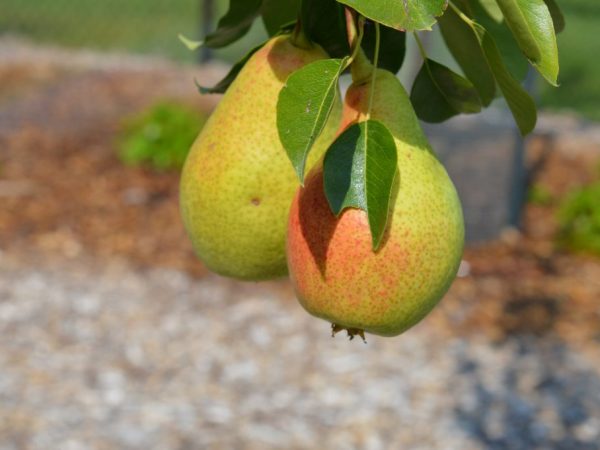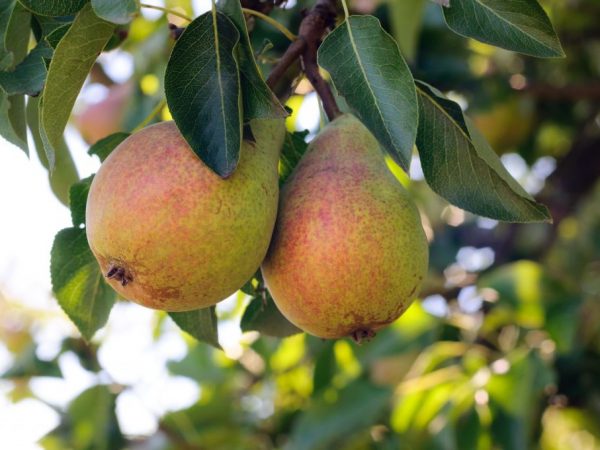Characteristics of early varieties of pears
Early varieties of pears are grown by many gardeners. They are suitable for regions where autumn comes quickly and frosts begin quickly. Therefore, it is especially important to cultivate them in central Russia. These species differ in comparison with small but sweet fruits. They ripen from mid-July to late August.

Characteristics of early varieties of pears
Moscow early
The history of the variety begins in the early 90s of the last century. Bred by the Russian breeder Susov at the Timiryazev Agricultural Academy. Many species have become parents. It was not originally intended for a specific region. Today it is successfully cultivated in the Moscow, central and northwestern Russian regions. Perfectly settled down in the Baltic countries.
The Moscow early (summer) pear variety has the fastest ripening times. The crop can be harvested in the last decade of July - early August. The fruits ripen together. Begins to bear fruit at the age of 6-7 years. Any early flowering pear that is cultivated in the region can serve as pollinators.
Description of the tree
The culture is a medium layer - it reaches a height of 4-5 m. The crown has the shape of a pyramid. The main trunk and lateral branches are green with a gray tint. Average leafiness.
Description of fruits
The shape is pear-shaped, correct. Ribs and tubercles are absent. Medium size, weight is 120-140 g. Color is greenish-yellow. At full maturity, flush is present on the sides. The skin is firm but soft.
Taste qualities are high - the pulp is juicy, tender, semi-oily, melting, with a slight sourness. It has a grainy texture. The color is almost white, with a pale cream shade.
The advantages of the variety:
- Good yield.
- Resistant to frost, therefore well suited for central Russia. After all, the growing season of early varieties of pears begins in the spring, when there is still a threat of frost.
- It is immune to some diseases, especially to such common ones as scab.
- Early maturity is good for their implementation, because the first fruits on the market are always appreciated.
The disadvantages include the fact that the fruits do not have a long shelf life. They do not lose their presentable appearance from 5 to 14 days. Also, the plant is susceptible to diseases such as bacterial cancer and powdery mildew. Among the pests that affect the culture can be distinguished: moths, hawthorns, pear gall mites. Therefore, it is always necessary to carry out preventive measures.
The tree requires good watering, especially at a time when the fruits are poured. If this condition is not met, pears become tart and dryish.
June early
The variety is one of the most popular summer varieties. Bred in the North Caucasian Zonal Research Institute of Horticulture and Viticulture by scientists Sergeev and Kostetskaya. Zoned in the Krasnodar Territory. It was originally intended for the southern regions.
Pear June (July) early allows you to feast on ripe fruits faster than other summer species. The crop can be harvested 10 days earlier (compared to the rest) - in the middle of summer. Begins to bear fruit 6-7 years after planting.
Description of the tree
Description of the tree: medium height. The crown has a rounded, pyramidal shape. Shoots are straight, medium-sized, slightly raised. Their color is brownish-brown, maybe greenish. The surface is flaky. The kidneys are round, bent. Average leafiness. Leaves are light green in color with a smooth surface. They have an oblong, oval shape. Inflorescences are white, their number is large. There is no aroma.
Description of fruits

The variety has many advantages
The July summer pear has a pear-shaped, oblong shape. The fruits are small. Their average weight is only 90 g. Fruits are approximately the same size. The skin is matte, smooth. There are small, almost imperceptible black dots under the skin. The skin is yellow when ripe. The barrel from the sunny side is characterized by the presence of a pale red blush. The inside is medium-dense, light yellow, juicy, oily. There are no stony inclusions. The taste is sweet and sour, with a pleasant aroma. The peduncle is long, curved.
The July pear has many advantages:
- high yield - although the fruits are small, there are a lot of them;
- pears do not crumble - this makes it possible to remove them without damage;
- increased winter hardiness - tolerates temperatures even up to -30˚С;
- good transportability;
- has scab resistance.
Moldavian and Mlievskaya early
This species represents the best varieties of summer pears: Moldavskaya and Mlievskaya. The author of the Moldavian KK Dushutina is an employee of the Moldavian Research Institute of Horticulture, Viticulture and Winemaking. Obtained by crossing two popular varieties, namely Williams Summer and Lyubimitsa Kappa. And Mlievskaya is a hybrid of "Esperen" and "Ukrainian Gliva"
When grafted, both trees begin to bear fruit quickly compared to 3-4 years. Pears ripen in mid-July and are harvested until the end of August. Is self-fertile. But to obtain a high yield, the following pollinators are used: Swallow, Krasivaya, Bere Giffard. Often these varieties are grafted on quince. This improves the palatability. It also increases the resistance of the culture to disease.
Description of the tree
Description of the tree: vigorous, pyramidal, flattened crown, dark green leaves. The shape is elliptical. Pointed tips.
Description of fruits
Medium fruit. Their weight reaches 150 g. The shape is pear-shaped, oblong. The color is yellow-green. The skin is thin, smooth. The pulp is oily, very juicy, sweet or sweet and sour.
When consumed, there is no astringent taste, which not all species can boast of. When tasting, he received an expert assessment of 8.5 points out of 10 possible. They are used for different purposes. Fresh - for fruit salads, processed - for jams, preserves, candied fruits, compotes. Dried are used for muesli.
The advantages of the variety:
- high and stable yield - up to 70 kg of fruits are harvested from one tree;
- excellent winter hardiness - ideal for growing in mid-latitudes;
- versatility of use;
- has resistance to fungal and bacterial diseases.
The downside is that the fruits do not last long. They should be consumed no later than 7-10 days later. Do not tolerate transportation, as the skin is thin.
Conclusion
The early varieties of pears are among the most sought after. The harvest can be obtained already in the middle of summer. With proper care, they give good performance. The palatability is also very high - the fruits are sweet and juicy.


